From wallpaper to world famous – a story of reinvention
Just occasionally, a product can be given a whole new lease of life, a new target audience and a new use. It is not so much revitalised as reinvented. Kotex started life as absorbent bandages during WWI and went on to become one of the pioneers of sanitary towels. Viagra was destined to become a high-blood pressure relieving drug until an unexpected alternative use was discovered.
This tale begins in the late 1920s, when Cleo McVicker, just 21 years old, was given the task of winding down Kutol, a Cincinnati based soap company, selling off its assets before closing the company. However, Cleo managed to do such a good job that he was able to keep the company afloat – just.
 Cleo knew the company needed a new revenue stream and hired his brother, Noah to help him set about trying to find one.
Cleo knew the company needed a new revenue stream and hired his brother, Noah to help him set about trying to find one.
In 1933, at a meeting with Kroger Grocery, they spotted their opportunity. Kroger were on the look-out for a wallpaper cleaner. At the time, coal was the leading way to heat one’s home. It was more efficient and cheaper than wood but tended to leave a layer of soot everywhere. This was especially difficult to clean off wallpaper as you couldn’t get it wet. Vinyl wallpaper wasn’t readily available.
Cleo promised them that Kutol could make and supply them with a wallpaper cleaner – even though at the time he didn’t know if they could deliver. Kroger ordered 15,000 cases but insisted on a $5,000 penalty (about $90,000 today) if Kutol didn’t deliver on time. This penalty was more than Kutol would have been able to pay so, in effect, Cleo was gambling with the company’s ability to fulfil the order. Luckily for the brothers and the company, Noah worked out how they could manufacture a pliable, putty-like substance that worked well as a wallpaper cleaner.
The new cleaner sold well and the company looked forward to a bright future – which it enjoyed for the next fifteen or so years.
But then their fortunes started to change.
Cleo McVicker had died in a plane crash in 1949 and Joe McVicker, Noah McVicker’s nephew had been hired to replace him. He was to face a new challenge.
After WWII, sales had begun to fall. Not only were vinyl wallpapers coming onto the market, but homes were switching from coal stoves to oil and natural gas that burned cleaner.
Kutol was in danger of becoming obsolete.
However, family came to the rescue in the form of Kay Zufall, Joe McVicker’s sister-in-law.
Kay was running a nursery school and had been looking for cheap materials that she could use with the class to make Christmas decorations. She read in a magazine that wallpaper cleaner could be used in this way, so she went out and bought some Kutol’s wallpaper cleaner to try it out.
The kids loved it and it worked a treat.
Knowing the problems that Kutol had, she called Joe and suggested that they stopped making the cleaner and started making a toy instead.
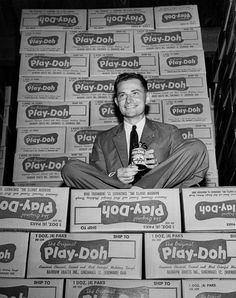 Joe knew a good idea when he heard one and got to work on a slight modification to the product’s formulation. He removed the detergent from the putty and added some almond scent and some colouring to the originally white dough.
Joe knew a good idea when he heard one and got to work on a slight modification to the product’s formulation. He removed the detergent from the putty and added some almond scent and some colouring to the originally white dough.
Joe decided the new product needed a new name and was considering calling it “Kutol’s Rainbow Modeling Compound”. On hearing it, Kay told him it was awful and that she and her husband would come up with a better one.
A few days later, they came back with their suggestion – “Play-Doh”. Joe, to his credit, could see it was a better name and they went with it.

To date, 3 billion cans of Play-Doh have sold, and some 500 million cans are still sold yearly in 80 countries. The brand is in the National Toy Hall of Fame and has made Time magazine’s list of the greatest toys of all time.
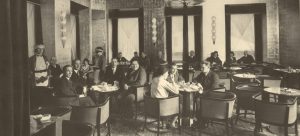
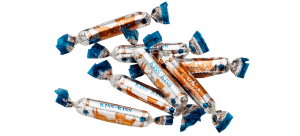

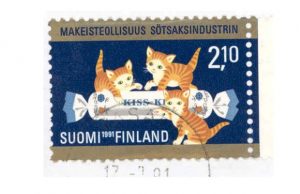 These soft, cuddly, cute, caramel kittens established themselves as the core brand icon and became extremely well known, so much so that in 1991 the little “Karamellikääreen” (caramel wrapper) cats appeared on a stamp celebrating the centennial of Finland’s confectionery industry, and no doubt on countless love letters.
These soft, cuddly, cute, caramel kittens established themselves as the core brand icon and became extremely well known, so much so that in 1991 the little “Karamellikääreen” (caramel wrapper) cats appeared on a stamp celebrating the centennial of Finland’s confectionery industry, and no doubt on countless love letters.
 Chupa Chups were the idea of Enric Bernat, an entrepreneur from Catalan, who, on hearing an irate mother cursing her child for taking a sweet in and out of their mouth, “saw sweets didn’t suit their main consumers, children. They got their hands sticky and ran into trouble with their parents. So I stuck a sweet on a stick.”
Chupa Chups were the idea of Enric Bernat, an entrepreneur from Catalan, who, on hearing an irate mother cursing her child for taking a sweet in and out of their mouth, “saw sweets didn’t suit their main consumers, children. They got their hands sticky and ran into trouble with their parents. So I stuck a sweet on a stick.”
 According to some sources, the painter went to work immediately, working on newspapers lying around in the café. Others don’t mention how and when he started working but all seem to agree that it took him only about an hour to come up with the daisy shape containing the wordmark. He also strongly recommended that, rather than follow conventional wisdom and have the logo on the side of the product, his new design should be placed on top of the lolly, so that it could always be viewed in its entirety.
According to some sources, the painter went to work immediately, working on newspapers lying around in the café. Others don’t mention how and when he started working but all seem to agree that it took him only about an hour to come up with the daisy shape containing the wordmark. He also strongly recommended that, rather than follow conventional wisdom and have the logo on the side of the product, his new design should be placed on top of the lolly, so that it could always be viewed in its entirety.
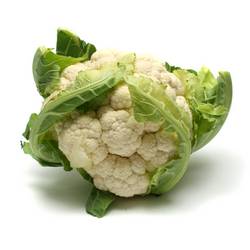

 The facilities were pretty basic on board with two portable cabins lashed to the deck, one with bunkbeds for the drivers and a kitchen to provide meals in the other one.
The facilities were pretty basic on board with two portable cabins lashed to the deck, one with bunkbeds for the drivers and a kitchen to provide meals in the other one.